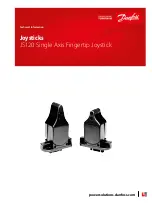
SYSTEM ARCHITECTURE
SNAP PAC R-Series Controller User’s Guide
20
System Architecture
Because SNAP PAC R-series controllers are a combination of controller and I/O processor,
their architecture is more complex than that of devices such as the SNAP EB-series brains,
which are I/O processors only. The next few pages show the capabilities of this versatile
system, starting with the simplest and moving to the more complex. Your application may
require only some of these capabilities, but as your needs expand, remember that SNAP PAC
R-series I/O can be used in all the ways shown,
simultaneously
.
Understanding the SNAP PAC R-series Controller
The SNAP PAC R-series controller merges two functions that are usually located in separate
pieces of hardware: input/output processing and flowchart-based control. These two
functions are handled by two “sides” of the controller, as illustrated below.
Share strategy variable data
with Opto 22 controllers and
other SNAP PAC R-series con-
trollers (peer-to-peer communi-
cation).
PAC Control
(writes to memory
map Scratch Pad
areas)
Memory map
Scratch Pad areas
PAC Control does not write directly to peers, but places
data in the memory map so peers can retrieve it by read-
ing memory map addresses.
See
PAC Control User’s Guide
&
Command Reference
.
Also see controller’s memory map in
OptoMMP Protocol
Guide
.
Communicate with Mod-
bus/TCP hardware or software.
Modbus/TCP
See the
Modbus/TCP Protocol Guide, form #1678
.
Communicate with Allen-Bradley
Logix PLC systems
EtherNet/IP
See the
EtherNet/IP for SNAP PAC Protocol Guide
, form
#1770.
Exchange I/O point data with
third-party software such as
HMIs.
OptoOPCServer
and controller’s
memory map
Purchase OptoOPCServer separately. See
OptoOPC-
Server User’s Guide
and the memory map in
OptoMMP
Protocol Guide
.
Exchange PAC Control strategy
variable data with third-party
software such as HMIs.
FTP and control-
ler’s file system
OptoOPCServer Purchase
OptoOPCServer separately. See
PAC Control
User’s Guide
and
OptoOPCServer User’s Guide.
Write your own software applica-
tion to communicate with the
system.
C++ or Active X:
OptoMMP Com-
munication Toolkit
and controller’s
memory map.
Opto 22’s IEEE
1394-based proto-
col and controller’s
memory map.
See
OptoMMP Protocol Guide.
This task
Can be done using these methods
Details and references for information
Recommended
Alternate
















































